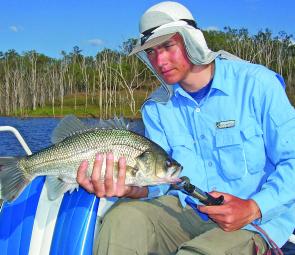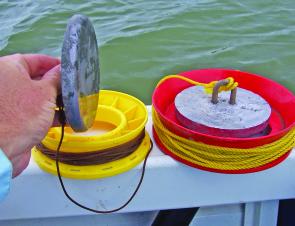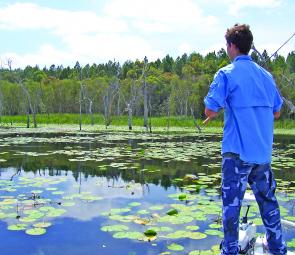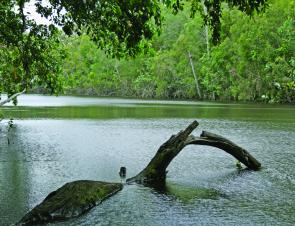As I paddled quietly around the bend, the snag came into view and what a beauty it was.
Just up ahead on the left hand bank, a huge gum tree that had once towered high above the river, now found itself sprawled across the shady pool. Its massive trunk provided the perfect ambush point for a waiting predator and in these waters it had to be a big bass hangout. I was keen to make the most of the opportunity it presented.
Unfortunately the wind had other ideas.
Every time I paddled into position to fire a cast in tight along the trunk of that big old gum tree, the swirling breeze and gentle current would catch my little craft and push me out of position. Talk about frustrating! Here I was with the perfect snag, yet the windy conditions meant I was unable to fish it effectively. Right about then I realized that I needed a quick and convenient anchoring system in my canoe if I wanted to make the most of my fishing opportunities.
Now I know that the idea of a compact anchoring system is nothing new. Many small boat anglers have been using them for years, but I just thought that given the current growth in popularity of canoe and kayak angling, it might be worth looking at the system we use in a little more detail.
Actually, it’s a little bit misleading to call what we use a system as it’s a pretty basic contraption and anyone can knock one up in a short time.
We call our anchors ‘Blobbies’ for obvious reasons. They are simply a blob of lead and they rely on their weight to hold bottom rather than having any pointy bits to dig in or catch on the bottom structure. Sure, they are nowhere near as effective as a regular anchor, but in terms of convenience and ease of use, they are miles ahead.
I mainly use the Blobby for situations like the one described above; when I just want to hold in one spot for a short period of time while I work an area over thoroughly with lures. Once I’m finished, I simply pull the Blobby up and move onto the next spot before sending it back down to hold me in position again.
Before getting into the nuts and bolts of making a Blobby anchor, we need to acknowledge the potential dangers of working with molten lead.
First of all, the stuff is hot, bloody hot in fact, and if it comes in contact with your skin then a severe and painful burn is a distinct possibility.
Secondly, the fumes are not good for you, so make sure you work in an open space like a shed where they have a chance to dissipate.
Thirdly, and very importantly, molten lead and water should not come into contact with each other as the results are literally explosive.
Nevertheless, I would consider making a Blobby anchor to be no more dangerous than moulding your own sinkers. So, if you have some experience in that area, it should be straightforward for you. For those that haven’t, common sense will dictate caution so make sure you wear enclosed shoes and clothes, safety goggles and heat resistant gloves to protect against spillage.
The first thing you will need is some lead. I got mine by buying up old sinkers at garage sales for a couple of dollars, and it was easy to scrounge up enough to make a couple of anchors.
The next thing you need is an old copper saucepan. Once again, I picked mine up at garage sale for a few dollars. Do not use a saucepan from your regular kitchen set, as once you have melted lead in it, it should no longer be used for cooking.
When selecting a pan, the trick is to pick one that is not too big. The bigger the saucepan used, the more lead is required to fill it. Too much lead means too much weight for the anchor. An ideal size to use is a saucepan with about a 5” diameter (125mm). It also needs to have parallel sides; otherwise, you will have to wreck your saucepan to get the finished anchor out.
I currently run two different weighted Blobbies. The lighter one is about half an inch thick and weighs around 1.75kg. The heavier version is just under an inch thick and weighs around 2.5kg.
The larger Blobby is heavy enough to hold my 4.4m tinny on the spot in a reasonable breeze, while the lighter blobby is ideal for the canoe in most conditions. I often use both of them when I am lure casting; with the heavier one holding the boat in position while the lighter one stops the other end of the boat from swinging around too much.
To make the anchor, all you need to do is melt the lead in the saucepan. I simply used one of those portable gas cookers as the heat source and it worked perfectly.
Once the lead has melted, use an old spoon to scoop the dross off the top, leaving a nice shiny silver liquid. Then all that remains is to sit an anchor point in the molten lead and turn off the gas and wait for the lead to cool down and solidify.
I tried several methods to achieve this and found the easiest way was to use a pair of long handled tongs to hold an old D shackle in the middle of the lead. Once the heat is off, it doesn’t take long for the lead to set, so you should only need to hold it for a minute or so. Once the lead has cooled enough so that the shackle will stand up by itself, you should then leave it for a couple of hours to make sure it is no longer hot to touch.
Once it has cooled, tip the saucepan up and empty your new blobby anchor out.
All that remains at this point is to attach about 10m of thin nylon rope and wind it around a plastic handcaster. I use a 150mm plastic handcaster that fits either Blobby inside perfectly; it keeps everything neat and tidy.
Making a Blobby really is a very affordable and straightforward process.
Once you have your Blobby, or better yet a pair of Blobbies, you will be amazed how often you use them. I’ve found they are almost essential in the canoe and I rarely put my tinny in without two Blobbies on board.
When they are used in conjunction with a bow mounted electric, they are fantastic for quietly sneaking into position and holding yourself on the spot while you give the area a thorough workout.
They are also handy for holding your boat on the spot while trying to unsnag lures. I even use the heavy blobby to hold the boat on the bank while I go and park the car if I’m fishing solo.
Blobbies are very useful and if you give them a try I reckon you’ll soon be a Blobby fan too.
Reads: 3495
Catching big bass is much easier if you use a blobby anchor to hold the boat on the spot.

Blobby anchors and an electric motor make fishing quiet bays like this a breeze.

The finished product! The author’s Blobbies waiting to be deployed.

The lighter Blobby (being held in the picture) is only half an inch thick and only weighs 1.75kg.

Lure casting becomes more effective when you can position the boat exactly where you want and, more importantly, keep it there.

Snags like this are prime pieces of bass real estate. This is where a Blobby can really help out your fishing.




